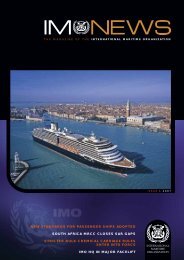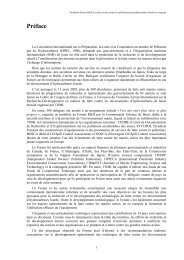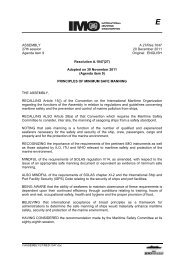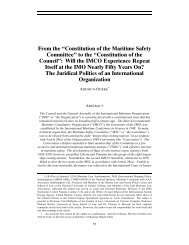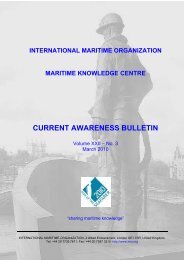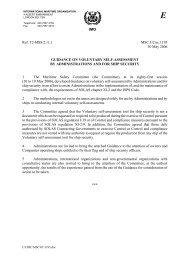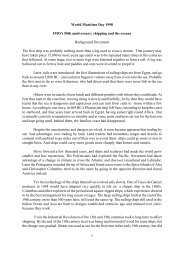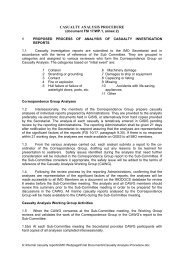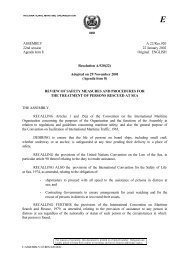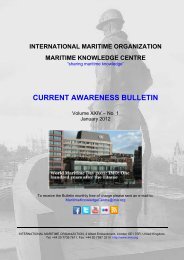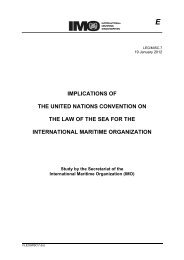Radioactive Waste Disposal at Sea: Public Ideas ... - IMO
Radioactive Waste Disposal at Sea: Public Ideas ... - IMO
Radioactive Waste Disposal at Sea: Public Ideas ... - IMO
You also want an ePaper? Increase the reach of your titles
YUMPU automatically turns print PDFs into web optimized ePapers that Google loves.
44 Chapter 3<br />
It seems quite plausible, then, th<strong>at</strong> it is not clear reasoning, but simple<br />
images, illustr<strong>at</strong>ive pictures, analogies, and even anecdotes th<strong>at</strong> make public<br />
ideas powerful and influential. They make it possible for transn<strong>at</strong>ional<br />
entrepreneurs to draw <strong>at</strong>tention to complex environmental issues and,<br />
equally important, to make sense of them in the public arena. It should therefore<br />
be expected th<strong>at</strong> policy entrepreneurs especially search for and select<br />
those ideas th<strong>at</strong> can effectively be expressed in metaphoric or symbolic<br />
forms. It follows th<strong>at</strong> the ideas and problems th<strong>at</strong> appeal most to policy<br />
entrepreneurs—in effect, the ideas and problems th<strong>at</strong> policy entrepreneurs<br />
tend to select and push—are those th<strong>at</strong> can be broken down into and communic<strong>at</strong>ed<br />
as simple and intuitively appealing metaphors, images, and symbols.<br />
22 “The ozone hole,” “Save the whales,” “biodiversity,” and “spaceship<br />
Earth” are some of the prominent examples of such environmental ideas<br />
and metaphors. 23 Nonenvironmental examples of policy entrepreneurs’ converting<br />
complex concepts into powerful populist themes and ideas also<br />
exist. 24 For these scholars, metaphors, images, and pictures th<strong>at</strong> can grab the<br />
public imagin<strong>at</strong>ion are of utmost importance in public communic<strong>at</strong>ion and<br />
societal dissemin<strong>at</strong>ion of ideas. 25<br />
In regard to contextual characteristics, an idea, if it is to be influential,<br />
must reson<strong>at</strong>e with historical experiences and must have a clear link to a<br />
currently pressing problem. As I have noted, policy entrepreneurs are most<br />
influential when they succeed in coupling their ideas and proposals to<br />
urgent problems; rarely do they have any control over the stream of problems,<br />
and seldom are they able to provoke a crisis th<strong>at</strong> makes decision makers<br />
search urgently for policy solutions (Polsby 1984, p. 169). Scholars have<br />
similarly found th<strong>at</strong> the persuasiveness of economic ideas is determined as<br />
much by current economic and political circumstances as by the structure<br />
of the ideas themselves (Hall 1989, p. 370). And historical studies of regul<strong>at</strong>ion<br />
also confirm the significance of the historical context for the power<br />
of ideas (McCraw 1984, p. 304). In summary, ideas must be fitted to existing<br />
intellectual and contextual circumstances in order to gain influence over<br />
policy. 26<br />
Apart from the intellectual and contextual circumstances, under wh<strong>at</strong> conditions<br />
should ideas and transn<strong>at</strong>ional entrepreneur coalitions be expected<br />
to have significant influence over regimes? This is an important question for<br />
the study of these transn<strong>at</strong>ional coalitions as well as any other ideas-based<br />
actor. Importantly, some ideas may raise serious distributive issues <strong>at</strong> the



